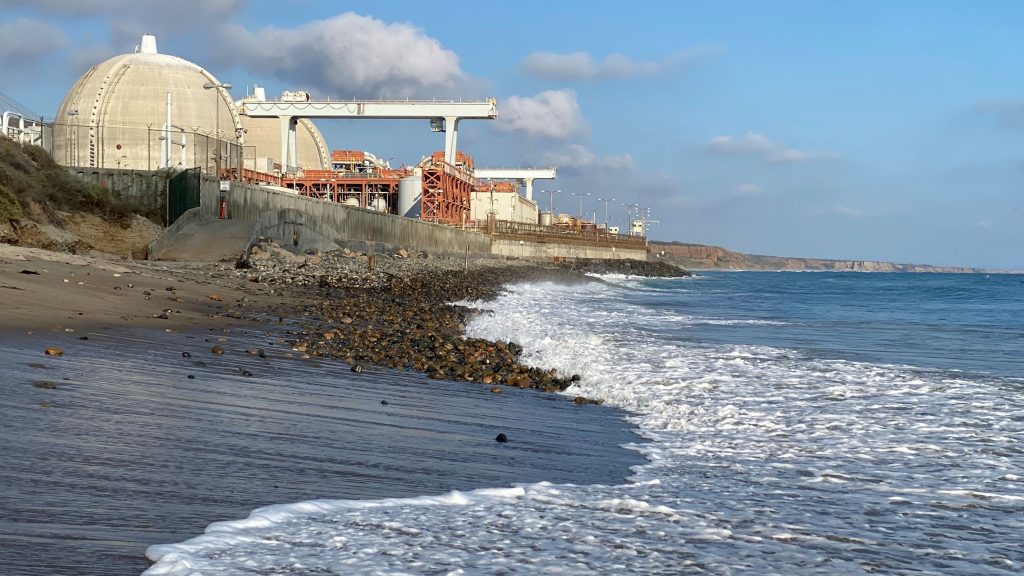 San Onofre Nuclear plant. Credit: Cia Romano,
San Onofre Nuclear plant. Credit: Cia Romano, Climate Change is Raging in Our Faces
An SSIT FutureProof Blog Post
Late summer 2021: we learn the flow of the Mississippi was briefly reversed by Hurricane Ida; rain fell at Greenland’s summit for the first time in known history; and we struggle to absorb the news of the possible collapse of the Atlantic Meridional Overturning Circulation (AMOC) and its planetary-scale implications.
These events are no longer unimaginable.
Climate change is raging in our faces, and these events are no longer unimaginable, thanks in part to widely panned science fiction movies such as 2004’s The Day After Tomorrow. The movie was the first to introduce the AMOC and its role in regulating climate, and The Day After Tomorrow became shorthand once the recent AMOC news broke. Who knew the eye-opening team of writer/director Roland Emmerich and The Coming Superstorm author Whitley Strieber could yield images so memorable they would immediately come to mind, in these dark days of 2021?
Of course, climatologists have long known exactly what is coming if we do not stop our headlong rush into disaster. But we live in a time where people know more about the Marvel Cinematic Universe than about the most basic science. The public needs to fully visualize climate disaster, and sadly, entertainment is likelier to reach people than any science engagement initiative. And the public needs to truly grasp that the disaster is coming to a neighborhood near them, and soon.
Envisioning Mayhem On A Planetary Scale – Timely?
We live in a time where people know more about the Marvel Cinematic Universe than about the most basic science.
“Outlandish” science fiction introduces the public to concepts beyond the average imagination. While Emmerich will never win an Oscar, he has a knack for scale. The jaw-dropping scene of seas breaking over the Himalayas as a lone monk sounds a temple gong – a key moment in Emmerich’s 2009 release, 2012 — took sci-fi mayhem to a new high (apologies). No one had ever seen that image before. And it caused… wonder. Is that even possible, viewers asked?
But here’s the point: Viewers did wonder. They wondered about climate change on the scale seen in TDAT and 2012. But both films had (relatively) happy endings. What happens when the failures of technology combine with climate change, promising an unhappy ending right down the road?
Nuclear Waste in Paradisiacal Southern California
Just an hour north of San Diego, just south of the glittering ultra-rich communities of Laguna Beach and Newport, twin containment domes rise to the west of Interstate 5 on the Pacific coast. Visitors exit at Old Highway 101, and drive down a steep sandy cliff road ending at San Onofre’s iconic surf beach. Near sunset, the foil surfers begin to congregate at the ancient beach shacks. It’s an idyllic and legendary spot, known as San-O to the locals. Idyllic until you look to the south and see the decommissioned San Onofre Nuclear Generating Station (SONGS) on the beach.
What you can’t see are the 3.6 million pounds of nuclear waste products stored on-site at San Onofre, just 100 feet from the shoreline. Subject to the crashing ocean and the vicissitudes of two faults that can produce strong earthquakes, directly adjacent to a major highway. Over 50 warning sirens were decommissioned in 2019 by Southern California Edison. Some local residents disagreed, to no avail. (Local authorities stated they were no longer necessary.)
As visitors approach SONGS, warning signs, made of metal and set into concrete posts, are set into the sand at close intervals. On the north side of the facility, several have already been taken by the ocean, demonstrating the eternal problem of designing signage around nuclear waste with radioactive half-lives of thousands of years. Corrosion is visible all over the facility.

Signage at San Onofre Nuclear plant. Credit: Cia Romano.
Radioactive Decay by the Sea
Visitors can still walk past the facility on a crumbling stretch of concrete walkway that is constantly monitored. “Do not stop. Keep moving,” says an amplified voice behind a rusting wall of razor wire. And the visitor does continue, past the menacing pile until the walkway ends and a brilliant stretch of seemingly pristine coastline emerges again. It, too, supports warning signs every few yards. The beauty of the coastline reminds the visitor that radiation is, in fact, invisible.
For a moment, the visitor can almost see the head of the Statue of Liberty buried in the sand, and two humans approaching it on horseback, as in 1968’s Planet of the Apes. How will future generations know what SONGS is, and what to do about it? (Speaking of Planet of the Apes, the otherworldly lake used to great effect in the film – Lake Powell – is almost gone, so no splashdowns – another victim of climate change.)
The saga of San Onofre is long and twisted, as The Guardian’s recent article described. The manager of regulatory affairs at San Onofre keeps it sunny. “The fact of the matter is, there’s, yes, it’s high-level nuclear waste. But, yes, the technologies that we’re using are extremely robust for any possible scenarios,” he states. What, exactly, is meant by ”robust”? The fallen warning signs and corroded nuclear facility — not to mention recent accidents during decommissioning — are not a good omen.
Which Future Do We Envision?
There is a tremendous difference between Emmerich’s the-world-is-ending-but-we’re-saved movies and the nihilism of a Planet of the Apes. Writers of the 1960s and 1970s lived with the Bomb and its terrible potential, and films of the 1980s were willing to go all the way on nuclear destruction – the US produced The Day After (1983), the UK produced Threads (1984), and the Soviet Union produced Letters From A Dead Man (1986, films listed in order of ascending realism and grimness). These films fearlessly depicted the obvious: a nuclear exchange spares no one. All three are required viewing.
What happens when the failures of technology combine with climate change, promising an unhappy ending right down the road?
The nuclear anxiety of the Cold War now seems quaint. While speculative writers of the late 20th-early 21st centuries have largely relegated nukes to the past, the situation at San Onofre reminds us of our sins — of assuming the future would take care of the future. The U.S. Nuclear Regulatory Commission enabled this consensual hallucination. Did it take climate change into consideration?
Will Wealth Save the Few from Danger?
Perhaps the most interesting moments in Emmerich’s multimillion-dollar B movies are related to social issues. Historically, the United States has been the tip of the spear in science fiction movies, saving the world (or leading the saving of the world, as in 1996’s Independence Day, also known as ID4).
But in 2012, the U.S. is no longer the most powerful country in the world. Once the seas rise and the privileged few make their escape, they must buy their passage on giant arks built and commanded by China. World leaders, including Queen Elizabeth and her corgis, are seen boarding the arks at the direction of Chinese security. Some of us noticed the role change.
Sadly, money cannot bargain with radioactivity. The residents of coastal Southern California are among the wealthiest in the country, communities where homes can cost $25,000,000 US. Spend an hour in any of these cities and the eye-popping wealth of the residents, many of whom are multigenerational trust funders, becomes more and more surreal. That’s what life in seaside Orange County is all about; the region spawns movies and reality shows about this exemplar of the one percent.
But the wealth seems to go everywhere except towards greater public safety. It is the land of perfect interiors, perfect clothing, perfect landscaping, where teenagers drive Bentleys, and you truly can find the best of everything. But it seems also to be where residents are far more concerned about visual perfection, than about mitigating the looming threat of a radiological accident at the San Onofre Nuclear Generating Station.
Maybe even with signs that can survive more than 50 years, to warn the unwary away.
Author Information
About Future Proof
Future Proof, a blog of the IEEE Society on Social Implications of Technology, seeks to open a dialog between formal studies on the societal implications of technology and the daily existence of all people.






 JOIN SSIT
JOIN SSIT